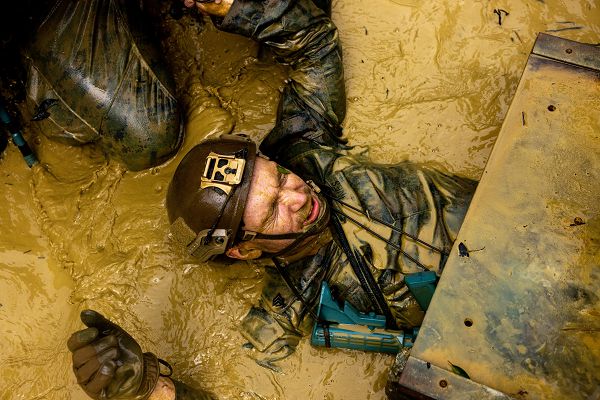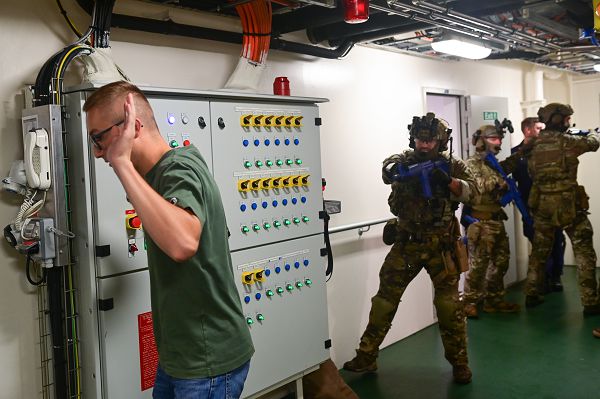- Details
- Hits: 343

Pacific Ocean. (August 31, 2023): In this photo by Seaman Tomas Valdes, Aviation Machinist's Mate 2nd Class Ashley Miranda, left, from Cocoa Beach, Florida, and Aviation Machinist's Mate Airman Jan Michael Simmonds, from Baltimore, Maryland, remove an engine from an F/A-18F Super Hornet aboard the aircraft carrier USS Nimitz.
Navy machinists are the unsung heroes of America’s mighty carriers. Their skill and perseverance keep the aircraft wings flying. These engine mechanics inspect, adjust, test and repair aircraft engines and propellers under brutal, around the clock operations matching the tempo of the air wings. They also install, maintain, and service aircraft engines of many types including their unique gear boxes and related fuel and lubrication systems. They evaluate engines for degradation using various test equipment and repair propellers and other types of damage in real time.
- Details
- Hits: 340

Okinawa, Japan. (August 31, 2023): In this photo by Corporal Michael Taggart, Marine Corps Sergeant Zachary Thacker negotiates an obstacle as part of the endurance portion of Jungle Leaders training at the Jungle Warfare Center at Camp Gonsalves, Okinawa. The course is designed to assess both the physical and psychological resilience of Marine leaders in a harsh jungle environment. Thacker, from Paducah, Kentucky, is a rifleman with the 2nd Battalion, 7th Marines.
As the nation’s focus has shifted away from Middle Eastern deserts to jungle-based operations, the Marines have taken steps to cope with maneuvering in dense jungles with high overhead canopies that make reconnaissance extremely challenging.
The Jungle Warfare Training Center Camp is one of two jungle warfare training centers in the Department of Defense. Here the Marines learn to navigate through the dense jungle, repel down steep cliffs, and improve their ability to patrol through dense vegetation and steep jungle terrain. Marines learned to thrive in harsh, tropical environments while practicing basic jungle survival skills including jungle medicine, land navigation, observation techniques. Following the classes, the Marines conducted practical application of what they learned through different mission sets and in particular the art of “Stalking" their prey. Stalking someone may be frowned upon in civilian life but is a highly prized skill for Marine reconnaissance and sniper teams.
Marines worked in teams to approach, observe, and evade potential targets that were constantly changing as they would in a real-life situation. For all the fancy innovative technologies that have emerged for reconnaissance, it is still well-trained Marines with their boots in the mud that provide the best intelligence on the enemy in the jungle.
- Details
- Hits: 305

Seymour Johnson Air Force Base, North Carolina. (September 1, 2023): In this photo by Lance Corporal Anakin Smith, Marines with Marine Wing Support Squadron 272 and Sailors assigned to Navy Cargo Handling Battalion 1 conduct forward refueling-point familiarization with a U.S. Navy P-8A Poseidon reconnaissance aircraft during Large Scale Exercise 2023. This annual event is designed to refine how we synchronize maritime operations across multiple fleets when operating as a joint force at sea. The training is based on a progression of scenarios to assess and refine modern warfare tactics and concepts. Marine Wing Support Squadron 272, based at Marine Corps Air Station New River, provides all manner of aviation ground support for air wings on land and at sea. Nicknamed the “Untouchables,” the 272nd does ground refueling, aircraft recovery, expeditionary airfield services, and even does its own weather forecasting. In addition, the wing provides engineering, mess facilities, airfield communications, and security for remote airfields or temporary locations ashore.
The Sailors assigned to Navy Cargo Handling Battalion 1 are experts at expeditionary logistics for Marine Air Wings much as they did during World War II as “stevedores” or special construction battalions.
These units are taking part in an enormous experiment of sorts involving multiple aircraft carriers and amphibious readiness groups battling it out in both the real and virtual worlds. For years, Navy doctrine centered on keeping carrier and amphibious strike groups in tight formations as they needed to be in close proximity to be effective. The advent of drone technology and the need to operate at greater distances has caused naval leaders to evaluate new operational theories to adapt to this new reality.
Large Scale Exercise 2023 is a part real, part virtual training event involving 25,000 Sailors and Marines from the U.S. Pacific Fleet and Naval Forces Europe-Africa. The exercise pitted twenty-five live and fifty virtual ships against each other in various realistic scenarios that simulate how they will fight the next war. To add to the realism, no advanced notice was given to crews who found themselves “fighting with what they have” as they would in an actual war. The Marine’s tested their ability to put forces ashore to defend maritime choke points and novel tactics were developed like deploying anti-ship missiles ashore to attack ships at sea.
- Details
- Hits: 656

Atlantic Ocean. (August 22, 2023): To most Americans, the Coast Guard is famous for dramatic rescues at sea but the service has another branch that is every bit as elite as any special forces in the U.S. military. Called Tactical Law Enforcement Teams or TACLETS, these highly specialized units conduct high-risk law enforcement and counter-narcotic operations at sea. In this photo by Petty Officer 3rd Class Mikaela McGee, a Tactical Law Enforcement Team conducts a mock boarding with active role-players from the crew of the BSAM Garonne, a French navy support vessel. The team practiced its boarding tactics while participating in Operation Nanook, an annual Canadian-led exercise to advance shared maritime objectives.
TACLET operators perform some of the most difficult, and dangerous, missions in the military. Besides interdicting drug smugglers, Coast Guard TACLETs are tasked with preventing terrorist attacks on U.S. forces in foreign ports. The 1989 National Defense Authorization Act designated the Coast Guard as the lead agency for the detection and monitoring of aerial and maritime trafficking of illegal drugs into the United States. The act authorizes the Guard to interdict and apprehend suspected drug traffickers and makes ships available to carry out these responsibilities.
Today, there are TACLET personnel assigned to Navy vessels around the world to investigate suspicious contacts and to conduct boardings of “ships of opportunity” transiting areas frequently used by smugglers. Although famous for saving wayward skippers at sea, the Coast Guard is also the premier maritime law enforcement agency for the U.S. military.
- Details
- Hits: 399

Gulf of Aden. (August 26, 2023) The U.S. Navy is on the hunt for pirates and drug smugglers in some of the most dangerous waters in the world. In this photo by MC2 Kerri Kline, Sailors aboard the guided-missile destroyer USS Thomas Hudner depart the ship in a rigid-hulled inflatable boat during visit, board, search, and seizure operations. The Hudner is underway with the U.S. 5th Fleet Area to ensure maritime security and stability in the Middle East region.
The Gulf of Aden is notorious for attempted hijackings and human/drug smuggling, mostly by pirates coming from nearby Somalia and Yemen. The Gulf of Aden leads to the Red Sea and is part of the vital Suez Canal shipping route used by over 21,000 ships a year that transport approximately eleven percent of the world’s oil.
In the late 2000s, the Gulf evolved into a hub for pirate attacks on commercial shipping as well as a highway for drugs and weapons shipments from Iran to its allies in Yemen. In both nations, there are high levels of unemployment, poverty, violence, and corruption that has created a climate where piracy and smuggling has flourished.
The pirates operate very small craft and carry small arms and occasionally rocket propelled grenades to attack civilian ships. Particularly vulnerable are luxury yachts that are tempting targets for opportunistic attacks, hijackings, or armed robbery.
In addition to warding off desperate pirates, the Navy must also confront attempts by Iran to ship military supplies to its Houthis allies in Yemen in violation of international sanctions. Under international law, military cargoes are not permitted to be shipped to the warring parties in Yemen and are subject to seizure. One example of such a seizure came in December 2021 when the USS Tempest and USS Typhoon interdicted a stateless fishing vessel transporting a cache of illicit weapons including 1,400 AK-47 assault rifles and 226,600 rounds of ammunition bound for Yemen.
- Details
- Hits: 367

Fort Belvoir, Virginia. (August 24, 2024): In this photo by Bernardo Fuller, Army Specialist David Lashner, assigned to the 3rd U.S. Infantry Regiment, also known as the “old Guard”, unveils the engraved name of Medal of Honor recipient retired Army Colonel Paris D. Davis at the National Museum of the U.S. Army. Col. Davis received our nations’ highest award for his actions while serving with the 5th Special Forces Group (Airborne) in Vietnam in 1965.
Captain Davis commanded a detachment of the U.S. Army 5th Special Forces Group (Airborne) while serving as an advisor to Republic of Vietnam troops. He led these soldiers on their first combat mission, a daring nighttime raid against a superior Viet Cong force. While returning from the successful raid, Captain Davis and his company were ambushed and sustained many casualties.
Constantly exposing himself to enemy fire, Captain Davis rallied his disorganized troops while expertly calling in artillery to within 90 feet of his own position. Although wounded in the leg, he aided in the evacuation of other wounded men of his unit but refused medical evacuation himself.
He then ignored intense enemy fire to rescue a seriously wounded comrade and, while carrying the man to safety, was wounded a second time. Despite these wounds, Captain Davis again refused medical evacuation, remaining with his troops under fire. After repelling several Viet Cong assaults, Captain Davis went on to save a U.S. advisor under his command who had been wounded during the initial ambush and was presumed dead.
For his selfless and courageous acts on that day, Colonel Davis will live forever in our national memory for going above and beyond the call of duty.


